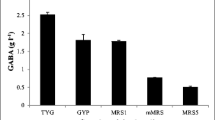Abstract
Glutamate excretion due to amino acid starvation was investigated in “stringent” and “relaxed” strains ofEscherichia coli. The observed excretion process isrelA-dependent, carrier-mediated, and glutamate-specific. After induction, excretion was detected within less than 2 min and continued for more than 5h with a rate of 7–10 nmol (mg dry weight)−1 min−1. Using carbonyl cyanidem-chlorophenylhydrazone or polymyxin B nonapeptide, together with valinomycin, it was shown that glutamate excretion is driven by the membrane potential.
Similar content being viewed by others
Abbreviations
- CCCP :
-
Carbonyl cyanidem-chlorophenylhydrazone
- IPTG :
-
Isopropyl-β-d-thiogalactopyranoside
- PMBN :
-
Polymyxin B nonapeptide
- ppGpp :
-
Guanosine 3′,5′-bispyrophosphate
References
Alatossava T, Vaara M, Baschong W (1984) Polymyxin B nonapeptide sensitizesEscherichia coli to valinomycin and A23187 ionophores. FEMS Microbiol Lett 22:249–251
Broda P (1968) Ribonucleic acid synthesis and glutamate excretion inEscherichia coli. J Bacteriol 96:1528–34
Cashel M, Rudd KE (1987) The stringent response. In: Neidhardt FC, Ingraham JL, Low BL, Magasanik B, Schaechter M, Umbarger HE (eds)Escherichia coli andSalmonella typhimurium: cellular and molecular biology, vol. 2. Am Soc Microbiol. Washington DC, pp 1358–1385
Davis BD, Mingioli ES (1950) Mutants ofEscherichia coli requiring methionine or vitamin B12. J Bacteriol 60:17–28
Fiil N, Friesen D (1968) Isolation of “relaxed” mutants ofEscherichia coli. J Bacteriol 95:729–731
Gutmann M, Hoischen C, Krämer R (1992) Carrier-mediated glutamate secretion byCorynebacterium glutamicum under biotinlimitation. Biochim Biophys Acta 1112:115–123
Klingenberg M, Pfaff E (1967) Means of terminating reactions. Methods Enzymol 10:680–684
Krämer R (1994) Secretion of amino acids by bacteria: physiology and mechanism. FEMS Microbiol Rev 13:75–94
Krämer R, Lambert C, Hoischen C, Ebbighausen H (1990) Uptake of glutamate inCorynebacterium glutamicum. 1. Kinetic properties and regulation by internal pH and potassium. Eur J Biochem 194:929–935
Sarubbi E, Rudd KE, Cashel M (1988) Basel ppGpp level adjustment shown by newspoT mutants affect steady-state growth rates, andrrnA ribosomal promotor regulation inEscherichia coli. Mol Gen Genet 213:214–222
Schimz KL, Rütter B, Tretter M (1981) Determination of adenosine nucleotides with luciferin/luciferase from crude firefly lantern extract on a bioluminescence analyser. Adv Biotechnol 1:457–462
Schleyer M, Schmid R, Bakker EP (1993) Transient specific and extremely rapid release of osmolytes from growing cells ofEscherichia coli K-12 exposed to hypoosmotic shock. Arch Microbiol 160:424–431
Svitel AL, Cashel M, Zyskind JW (1993) Guanosine tetraphosphate inhibits protein synthesis in vivo. J Biol Chem 268:2307–2311
Tetu C, Dassa E, Boquet PL (1980) The energy-dependent degradation of guanosine 5′-diphosphate 3′-diphosphate inEscherichia coli. Eur J Biochem 103:117–124
Tosa T, Pizer LI (1971) Biochemical bases for the antimetabolite action ofl-serine hydroxamate. J Bacteriol 106:972–982
Uzan M, Danchin A (1976) A rapid test for therelA mutations inE. coli. Biochem Biophys Res Commun 69:751–758
Vaara M, Vaara T (1983) Polycations sensitize enteric bacteria to antibiotic. Antimicrob Agents Chemother 24:107–113
Xiao H, Kalman M, Ikehara K, Zemel S, Glaser G, Cashel M (1991) Residual guanosine 3′,5′-bisphosphate synthetic activity ofrelA null mutants can be eliminated byspoT null mutations. J Biol Chem 266:5980–5990
Author information
Authors and Affiliations
Corresponding author
Rights and permissions
About this article
Cite this article
Burkovski, A., Weil, B. & Krämer, R. Glutamate excretion inEscherichia coli: dependency on thereIA andspoT genotype. Arch. Microbiol. 164, 24–28 (1995). https://doi.org/10.1007/BF02568730
Received:
Accepted:
Issue Date:
DOI: https://doi.org/10.1007/BF02568730




